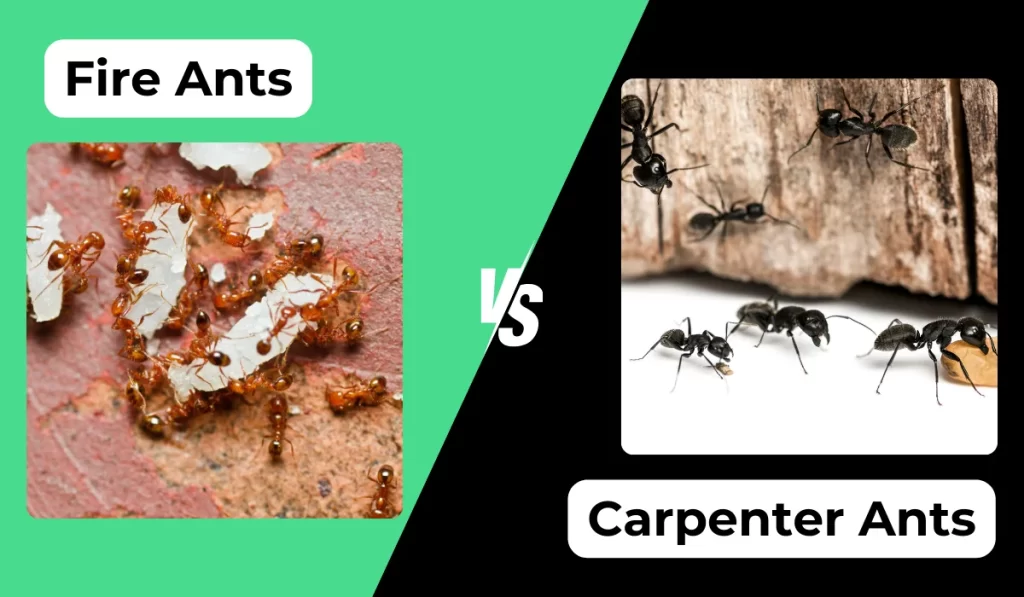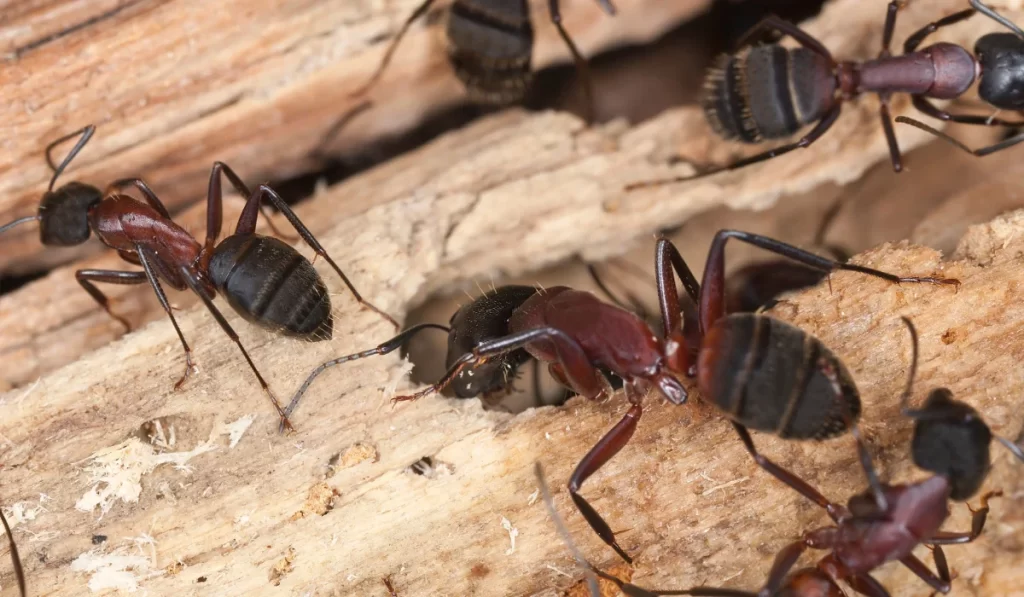If you’re a homeowner in Florida, chances are you’ve run into ants. But before grabbing a can of spray, it’s important to know which type you’re dealing with.
The two ant species that cause the most concern in our area are carpenter ants and fire ants, and while both can be a nuisance, they behave very differently.
Knowing the difference isn’t just about trivia. It can help you avoid costly repairs, protect your family, and choose the right pest control solution.
Key Takeaways
- Carpenter ants are large black ants that chew wood, while fire ants are smaller and sting when disturbed.
- Fire ants can cause allergic reactions, while carpenter ants slowly damage homes by nesting inside wooden walls.
- Each ant type eats different food and nests in different places, so they need different treatment plans.
- Pest control services help homeowners fix infestations and stop ants from building new colonies around the home.
Carpenter Ants vs. Fire Ants: Key Differences

So, how can you tell if you’re dealing with carpenter ants or fire ants? They might both be ants, but they look, behave, and feed very differently.
Here’s a side-by-side breakdown to help you quickly spot the difference:
| Features | Carpenter Ants | Fire Ants |
|---|---|---|
| Color | Black ants or dark brown | Reddish-brown (especially red imported fire ants) |
| Size | Large (up to ½ inch) | Small to medium (1/8 to ¼ inch) |
| Body Features | Smooth thorax, bent antennae | Uneven thorax, straight antennae, visible stinger |
| Behavior | Tunnel into wooden structures to build nests | Build large mounds, swarm when disturbed |
| Feeding Habits | Attracted to sweets, honeydew, and dead insects | Forage for protein, sweets, and greasy foods |
Why It Matters to Know the Difference
They Cause Different Kinds of Damage
You wouldn’t treat termites the same way you treat ants, and the same logic applies here.
With their strong mandibles, carpenter ants hollow out wood to form ant nests, which can silently eat away at your home’s framing. You might notice sawdust around baseboards or hear faint movement inside the walls as structural damage worsens.
Fire ants, especially the aggressive red imported fire ant, don’t destroy structures, but they can turn a yard into a danger zone of large colonies and painful stings.
Their aggressive behavior makes them a bigger threat when it comes to children and pets playing outside.
They Require Different Control Methods
Treating an ant infestation starts with identifying the species of ants involved.
Baits work well for both types, but only if they’re placed correctly and match the ants’ food sources. For example, carpenter ants are often drawn to sugary substances like honeydew, while fire ants prefer protein-rich options.
We’ve also seen infestations that include other types of ants like pavement ants, odorous house ants, acrobat ants, pharaoh ants, and even crazy ants, and they all behave differently. That’s why guessing can lead to wasted time and money.
Their Threat to People Is Not the Same
When ants bite, it’s usually not a big deal. But when fire ants sting, it’s a whole different story. Their venomous stings can cause swelling, itching, and in some cases, serious allergic reactions.
For sensitive people, this can be a medical emergency.
Carpenter ants, on the other hand, may bite if provoked, but their real threat lies in what they do to your home, not your skin.
Their Habits Hint at Bigger Problems
Every ant colony has its own set of nesting habits.
If you’re seeing carpenter ants, especially at night, they may have moved in due to rotting wood or moisture issues, things that could lead to termites down the line. These ants often build new colonies close to existing ones, so ignoring the issue won’t make it go away.
If fire ants are popping up in your yard, especially in sandy soil or near gardens filled with aphids (a source of honeydew), they’re not going anywhere without proper treatment.
Stop Ant Problems with Local Pest Pros
Whether you’re spotting ant mounds of fire ants or finding entry points where carpenter ants sneak inside, Rowland Pest Management has your back.
As a local pest control company serving Central Florida, we specialize in identifying and treating all types of ants using safe, targeted methods.
We provide:
- Fast, next-day service in places like Orlando, Lake Mary, and Winter Park
- Customized pest management plans based on your home’s needs
- Minimal-spray solutions (we use baits inside whenever possible)
- Ongoing pest control services to keep ants and other pests out for good
Schedule your free inspection and let us handle the ants for good.
Frequently Asked Questions
If you’re still unsure about what to look for or how ant problems can affect your home, here are a few more common questions homeowners in Florida often ask:
Can carpenter ants and fire ants live in the same yard?
Yes, it’s possible to have both at once. Fire ants build mounds in sunny soil while carpenter ants tunnel into moist wood, so their nests usually stay separate even if they’re close together.
What seasons are worst for ant infestations in Florida?
Spring and summer bring out most ant species in Florida. Warmer temperatures speed up colony growth and food searching, which makes it more likely to see ants indoors or around your property.
Can an ant problem spread to neighbors’ homes?
Yes, ant colonies can send out new queens to nearby yards. If one home has untreated ants, they can easily move through soil, walls, or shared spaces and cause problems for others.


